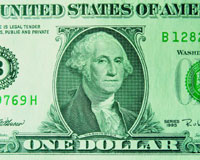Cost, abuse and danger of the dollar
Those who use dollars outside the US continuously pay a contribution to the US. It comes in the form of an inflation of 1.25 million dollars per minute. This is the result of the fast increase of the US foreign debt. Half of all USA's imports are simply added to the foreign debt and paid for by the foreign dollar holders through inflation.

Moreover these dollar holders do not seem to realize, that the dollar rate they are looking at, is nothing more than a dangerous facade. If they don’t understand what is still keeping it upright, the facade may hit them by surprise.
Meanwhile, well camouflaged, the dollar is at the center of several US’ conflicts.
World wide demand for dollars
Up to 1971, each US dollar represented a fixed amount of gold. The US disposed of enormous gold reserves, which covered the total value of all issued dollars. When foreign banks had more dollars than they wanted, they could exchange it into gold. That was the main reason why the dollar was accepted world wide.
In 1971 the gold guarantee for the dollar was lifted. In fact, this was an emergency move of President Nixon: the Vietnam War had cost more than the US could afford and more dollars had been printed than the gold reserves allowed. Since then, the value of the dollar is established by the law of offer and demand on the exchange markets.
In the early seventies the US still produced enough oil for its own consumption. To protect its own oil enterprises against foreign competition, oil imports were limited. In exchange for the lift of limitations, the OPEC countries promised they would only accept dollars for their oil. The dollar was the most used currency in the world trade. So nothing special?
Since 1971 everyone who wants to import oil, has to buy dollars first. That is where the fun starts for the US. Almost everybody needs oil, so everybody wants dollars.
Oil buyers from all over the world hand over their yens, crowns, francs and other currencies. They receive greenbacks in return. With those dollars they go and buy oil in the OPEC-countries. The OPEC-countries will spend the money again. Of course, they can do that in the US, but also in all other countries in the world. Everybody wants dollars, for everybody will need oil again.
Each country which purchases more than it sells, will see the value of its money diminish. If you can not do a lot with a currency, demand decreases and its exchange value goes down. But what is true for all other currencies, is not true for the US dollar. As long as the whole world needs dollars to purchase oil, there will always be demand.
Camouflaged conflicts
To keep the permanent demand for dollars going, oil sales must remain in dollars. That is why the US tries to keep as much influence as possible, as well on the US owned IPE and NYMEX world oil markets, as with the locals in power. By doing so the US secures its oil supply at the same time. Beyond that, lucrative contracts can be obtained from the local power, with which a maximum of benefits can be seized from the oil production.
But when the locals in power do not want to sell their oil in dollars anymore, the US has a problem. Then, the US-president will not explain how dependent the US is on the dollar demand. The conflict is always camouflaged. And to do so, always an emotional theme is chosen. In times gone by this was the danger for communists, today it is the danger for terrorists, fundamentalists and other popular bogies, like “the enemy has weapons of mass destruction” or “the enemy tries to make nukes.”
The fact that there is, rationally, not a single proof, does not matter. The emotions always win. Even the fact, that these accusations can be turned around and then can be proved, is noticedby hardly anyone. The US has weapons of mass destruction and has used them; the US has nukes and has used them, and even threatened with them still in 2000.
But once again, at the moment accusations are loaded with emotions humans switch off their intelligence. Reason is no argument for peace anymore. The theatre is only about the launched accusations. And because, as a result, only specialists of weapons of mass destruction or nukes are called upon to give their opinion, nearly nobody finds out what the conflict is really about.
Venezuela
In Venezuela, since many years, the US tries to pull down President Chavez, pretexting he is a dangerous communist. Chavez has nationalized the oil industry and has set up Barter-deals to export Venezuelan oil in exchange for medical care from Cuba and others. In Barter deals there is no necessity for dollars and the US has no profit from the oil trade.
Iraq
Until 1990 the US maintained lucrative commercial contacts with Saddam Hussein. He was a good ally. For instance, in 1980 he had tried to free the hostages at the US-embassy in Teheran.
But in 1989 Saddam accused Kuwait of flooding the oil market and making the oil price go down. The following year Saddam tried to annex Kuwait. It led to an immediate turn around of the attitude of the US. With the annexation Saddam would dispose of 20 percent of world oil reserves. The Iraqis were chased out of Kuwait by the US, with an alliance of 134 countries, and condemned to water and bread by a UN-embargo that lasted ten years.
Although the US sought a way to re-establish its influence in Iraq, Saddam’s switch to the Euro on November 6, 2000, would lead to the US invasion. The dollar sank away and in July 2002 the situation got that serious, that the IMF warned that the dollar might collapse. A few days later the plans for an attack were discussed at Downing Street. One month later Cheney proclaimed it was sure now, that Iraq had weapons of mass destruction. With this pretext the US invaded Iraq on March 19, 2003. The US switched back the oil trade into dollars on June 5, 2003.
There is a huge difference between trading Iraqi oil in euros and trading it in dollars. This will be explained below.
Iran
The US is in conflict with Iran, since it was thrown out of the country in 1979. According to the US, Iran is a dangerous country of fundamentalists.
The geographical position of Iran, between the Caspian Sea and the Indian Ocean, complicates US ambitions to control the rich reserves of oil and gas on the East side of the Caspian Sea. To transport this oil and gas to world markets without crossing neither Russia, nor Iran, pipelines had to be built through Afghanistan. Plans were made in the early nineties, but the pipelines are still not there.
Meanwhile the US tries to frustrate all competing projects of other countries.
Of course, this led to multiple conflicts of interest with Iran. George W. Bush would pretext the presence of Osama bin Laden to start a war against Afghanistan.
In 1999 Iran publicly stated it wanted to accept euros for its oil as well. Iran sells 30 percent of its oil production to Europe, the rest mainly to India an China and not a drip to the US, as a result of an embargo established by the US itself. In spite of Bush’s threatening tale, mentioning the country in his famous “axis of evil”, Iran started to sell its oil in euros from spring 2003.
After that, Iran wanted to establish its own oil-bourse, independent from the IPE and NYMEX. It would start on 20 March 2006. Considering the very weak health of the dollar at that time, a success of this bourse could have led to a catastrophe for the dollar and thus for he US. That is why tensions were very high at the beginning of 2006.
Finally the opening of the oil-bourse was postponed. After that Putin established an oil bourse in Russia as quickly as possible, which took away the interest of the Iranian oil bourse.
The US accuses Iran of wanting to make nukes. Because the US has not sufficient influence to switch back the oil trade into dollars, it probably hopes that the Iranian nuclear sites will be bombed once again so Iran would have to consume its oil instead of selling it in euros.
Moreover, a masterly plan has been conceived to take possession of the world market for nuclear fuel, in concert with a few other countries and using Iran as the pretext and the test case. With this plan the demand for dollars would be secured for a long time, even after the oil age.
Russia
Since 8 June 2006 Russia too has turned its back to the dollar. By selling the dollar surpluses to central banks, Putin took care that it had no influence on the dollar rate. However, the basis for the world wide dollar demand has decreased a lot. The US needs Russia for its plans to take possession of the world market for nuclear fuel, so a revenge by the US is unlikely.
Dollar economy
The dollar economy is not limited to the US. Oil reserves traded in dollars belong to it too. Also enterprises, banks and investments, anywhere in the world, belong to it when paid with dollars. They are like small islands of the dollar economy. Benefits and dividends are flowing back to the owners. The value of the investments is influenced by the rate of the dollar. Oil sellers, receiving their proceeds in dollars, are actors in the dollar-economy and usually behave like perfect representatives of the US’ interests. They consider this as their own interest.
Euro versus dollar
Since January 1993 the Euro is quoted. In July 2005 the rate is identical to what it was at its introduction: $1.22. The new currency has experienced quite some fluctuations during its short life. From the end of 1998 the Euro slides away, until the moment Saddam Hussein switches to the Euro in November 2000. Although the US switched the oil trade back into dollars in June 2003, the Euro continued its rise. Since spring 2003 Iran had started to sell oil in euros.
The Euro has become a small world currency. Between July 2004 and July 2005 the part of the dollar in world trade went down from 70 percent to 64 percent. A bit less then half of these 64 percent is related to US foreign trade. If the Euro wants to become as mighty as the dollar, it has still a long way to go.
In principle, the Euro contains the same risks as the dollar. As long as there would be a motor for a permanent demand for euros like, for instance, oil sales in euros, the Euro zone could make debts and let it increase indefinitely.
To avoid such debts, the Euro zone would have to export the equivalent of all euros needed outside its borders and keep the same amount in foreign currencies in their central bank. Why would they? The credit trick worked finefor the US during more than 30 years!
When oil producing countries would sell oil in two or three different currencies, like it has been considered in the past, this simply means that the three involved countries can do the same trick as the US does now. In the long run it would multiply the problem by three.
The only solution for this problem would be that oil selling countries accept all currencies on the market. Tehran has already taken into consideration to accept more than one currency and not just the Euro. Step by step.
By Rudo de Ruijter,
Independent Researcher
Netherlands, March 2007
The author can be contacted at www.courtfool.info
Subscribe to Pravda.Ru Telegram channel, Facebook, RSS!





